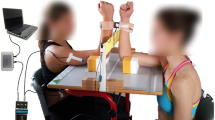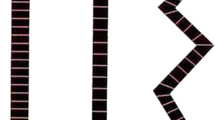Abstract
Four right-handed subjects performed rhythmic flexion and extension movements of the index finger in time with an auditory metronome. On each block of trials the forearm of the response hand was placed in a prone, neutral or supine position. In the flex-on-the-beat condition, subjects were instructed to coordinate maximum excursion in the direction of finger flexion with each beat of the metronome. In the extend-on-the-beat condition, subjects were instructed to coordinate maximum excursion in the direction of finger extension with each beat of the metronome. The frequency of the metronome was increased from 1.75 Hz to 3.50 Hz in eight steps (8-s plateaus) of 0.25 Hz. During trials prepared in the extend-on-the-beat pattern, abrupt transitions to either a flex-on-the-beat pattern or to phase wandering often occurred, particularly at higher pacing frequencies. In marked constrast, during trials prepared in the flexon-the-beat pattern such transitions were never present. Both the frequency and the alacrity of these transitions were greater when the forearm was in a prone or neutral position than when the forearm was in a supine position. These results are discussed with reference to the constraints imposed on the coordination dynamics by the intrinsic properties of the neuromuscular-skeletal system.
Similar content being viewed by others
References
Armstrong TJ, Chaffin DB (1978) An investigation of the relationship between displacements of the finger and wrist joints and the extrinsic finger flexor tendons. J Biomech 11:119–128
Basmajian JV (1979) Muscles alive. Williams and Wilkins, Baltimore
Batschelet E (1965) Statistical methods for the analysis of problems in animal orientation and certain biological rhythms. American Institute of Biological Sciences, Washington, DC
Batschelet E (1981) Circular statistics in biology. Academic Press, London
Bingham GP, Schmidt RC, Turvey MT, Rosenblum LD (1991) Task dynamics and resource dynamics in the assembly of a coordinated rhythmic activity. J Exp Psychol Hum Percept Perform 17: 359–381
Bradshaw JL, Nettleton NC (1981) The nature of hemispheric specialization in man. Behav Brain Sci 4: 51–91
Buchanan JJ, Kelso JAS (1993) Posturally induced transitions in rhythmic multijoint limb movements. Exp Brain Res 94: 131–142
Burgess-Limerick R, Abernethy B, Neal RJ (1991) Note: a statistical problem in testing invariance of movement using the phase plane model. J Mot Behav 23: 301–303
Byblow WD, Carson RG, Goodman D, Storlund C (1992) Measurement problems encountered in a dynamical analysis of multijoint and multilimb movements. Paper presented at the North American Society for the Psychology of Sport and Physical Activity Pittsburgh PA June
Carson RG (1993a) Manual asymmetries: old problems and new directions. Hum Mov Sci 12: 479–506
Carson RG (1993b) Manual asymmetries: dynamical analyses. Unpublished doctoral dissertation, Simon Fraser University, Burnaby, BC, Canada
Carson RG (1995) The dynamics of isometric bimanual coordination. Exp Brain Res 105: 465–476
Carson RG, Goodman D, Kelso JAS, Elliott D (1994) Intentional switching between patterns of interlimb coordination. J Hum Mov Studies 27: 201–218
Carson RG, Goodman D, Elliott D, Kelso JAS (1995) Asymmetries in the dynamics of interlimb coordination. In: Glencross D, Piek J (eds) Motor control and sensory-motor integration: issues and directions. North Holland, Amsterdam
Chao EYS, An K-N, Cooney WP, Linschield RL (1989) Biomechanics of the hand. World Scientific, Singapore
Cheney PD, Fetz EE, Mewes K (1991) Neural mechanisms underlying corticospinal and rubrospinal control of limb movements. Progr Brain Res 87: 213–252
Clough JFM, Kernell D, Phillips CG (1968) The distribution of monosynaptic excitation from the pyramidal tract and from primary spindle afferents to motoneurons of the baboon's hand and forearm. J Physiol (Lond) 198: 145–166
Duque J, Masset D, Malchaire J (1995) Evaluation of handgrip force from EMG measurements. Appl Ergon 26: 61–66
Fahrer M (1981) Interdependent and independent actions of the fingers. In: Tubiana R (ed) The hand, vol 1. WB Saunders, Philadelphia, pp 399–403
Ferguson GA (1971) Statistical analysis in psychology and education. McGraw-Hill, New York
Gordon AM, Huxley AF, Julian FJ (1966) The variation in isometric tension with sacromere length in vertebrate muscles. J Physiol (Lond) 184: 170–192
Gottlieb GL, Corcos DM, Agarwal GC (1989) Strategies for the control of voluntary movements with one mechanical degree of freedom. Behav Brain Sci 12: 189–250
Haken H (1983) Synergetics: an introduction, 3rd edn. Springer, Berlin Heidelberg New York
Haken H, Kelso JAS, Bunz H (1985) A theoretical model of phase transitions in human hand movements. Biol Cybern 39: 139–156
Hammond G, Bolton Y, Plant Y, Manning J (1988) Hand asymmetries in interresponse intervals during rapid repetitive finger tapping. J Mot Behav 20: 67–71
Hazelton FT, Smidt GL, Flatt AE, Stephens RI (1975) The influence of wrist position on the force produced by the finger flexors. J Biomech 8: 301–306
Horii E, An KN, Linscheid RL (1993) Excursion of prime wrist tendons. J Hand Surg [Am] 18: 83–90
Imrhan SN (1991) The influence of wrist position on different types of pinch strength. Appl Ergon 22: 379–384
Kelso JAS (1984) Phase transitions and critical behavior in human bimanual coordination. Am J Physiol 240: R1000-R1004
Kelso JAS (1994) The informational character of self-organized coordination dynamics. Hum Mov Sci 13: 393–413
Kelso JAS, Schöner G, Scholz JP, Haken H (1987) Phase-locked modes, phase transitions and component oscillators in biological motion. Phys Scripta 35: 79–87
Kelso JAS, Delcolle JD, Schöner GS (1990) Action-perception as a pattern formation process. In: Jeannerod M (ed) Attention and performance XIII. Erlbaum, Hillsdale, NJ, pp 139–169
Kelso JAS, DeGuzman GC, Holroyd T (1991) Synergetic dynamics of biological coordination with special reference to phase attraction and intermittency. In: Haken H, Koepchen HP (eds) Rhythms in physiological systems. Springer, Berlin Heidelberg New York
Kelso JAS, Bressler SL, Buchanan S, DeGuzman GC, Ding M, Fuchs A, Holroyd T (1992) A phase transition in human brain and behavior. Phys Lett A 169: 134–144
Ketchum LD, Thompson D, Pocock G, Wallingford D (1978) A clinical study of forces generated by the intrinsic muscles of the index finger and the extrinsic flexor and extensor muscles of the hand. J Hand Surg 3: 571–578
Kilbreath SL, Gandevia SCG (1993) Neural and biomechanical specializations of human thumb muscles revealed by matching weights and grasping objects. J Physiol (Lond) 472: 537–556
Kopell N (1988) Toward a theory of modelling central pattern generators. In: Cohen AH, Rossignol S, Grillner S (eds) Neural control of rhythmic movements in vertebrates. Wiley, New York, pp 369–413
Lemon R (1988) The output map of the primate motor cortex. Trends Neurosci 11: 501–506
Long C (1981) Electromyographic studies of hand function. In: Tubiana R (ed) The hand, vol 1. WB Saunders, Philadelphia, pp 427–440
Mardia KV (1972) Statistics of directional data. Academic Press, London
Murray WM, Delp SL, Buchanan TS (1995) Variation of muscle moment arms with elbow and forearm position. J Biomech 28: 513–525
Nathan RH (1992) The isometric action of the forearm muscles. J Biomech Eng 114: 162–169
Ojemann GA (1984) Common cortical and thalamic mechanisms for language and motor functions. Am J Physiol 246: R901-R903
Oldfield RC (1971) The assessment and analysis of handedness: the Edinburgh inventory. Neuropsychologia 9: 97–113
Peters M (1977) Simultaneous performance of two motor activities: the factor of timing. Neuropsychologia 15: 461–465
Peters M (1980) Why the preferred hand taps more quickly than the non-preferred hand: three experiments on handedness. Can J Psychol 34: 62–71
Peters M (1987) A nontrivial motor performance difference between right handers and left handers: attention as intervening variable in the expression of handedness. Can J Psychol 41: 91–99
Peters M (1990) Interaction of vocal and manual movements. In: Hammond GE (ed) Cerebral control of speech and limb movements. Elsevier, North-Holland, Amstzerdam
Peters M, Durding BM (1978) Handedness measured by finger tapping: a continuous variable. Can J Psychol 32: 257–261
Peters M, Durding BM (1979) Left-handers and right-handers compared on a motor task. J Mot Behav 11: 103–111
Phillips CG, Porter R (1977) Corticospinal neurones: their role in movement. (Monographs of the Physiological Society, 34) Academic Press, London
Rand RH, Cohen AH, Holmes PJ (1988) Systems of coupled oscillators as models of central pattern generators. In: Cohen AH, Rossignol S, Grillner S (eds) Neural control of rhythmic movements in vertebrates. Wiley, New York, pp 333–367
Ranney DA, Wells RP, Dowling J (1987) Lumbrical function: Interaction of lumbrical contraction with the elasticity of the extrinsic finger muscles and its effect on metacarpophalangeal equilibrium. J Hand Surg [Am] 12: 566–575
Riek S, Carson RG, Byblow WD (1992) Spatial and muscular dependencies in bimanual coordination. J Hum Mov Studies 23: 251–265
Schmidt RC, Shaw BK, Turvey MT (1993) Coupling dynamics in interlimb coordination. J Exp Psychol Hum Percept Perform 19: 397–415
Scholz JP, Kelso JAS, Schöner G (1987) Non-equilibrium phase transitions in coordinated biological motion: critical slowing down and switching time. Phys Lett A 123: 390–394
Schöner G, Kelso JAS (1988) Dynamic pattern generation in behavioral and neural systems. Science 239: 1513–1520
Schöner G, Haken H, Kelso JAS (1986) A stochastic theory of phase transitions in human hand movement. Biol Cybern 53: 442–452
Todor JI, Kyprie PM (1980) Hand differences in the rate and variability of rapid tapping. J Mot Behav 12: 57–60
Todor JI, Smiley-Oyen AL (1987) Force modulation as a source of hand differences in rapid finger tapping. Acta Psychol 65: 65–73
Treffner PJ, Turvey MT (1995) Handedness and the asymmetric dynamics of bimanual rhythmic coordination. J Exp Psychol Hum Percept Perform 21: 318–333
Truman G, Hammond GR (1990) Temporal regularity of tapping by the left and right hands in timed and untimed tapping. J Mot Behav 22: 521–535
Tzeng OJL, Wang WS-Y (1984) Search for a common neurocognitive mechanism for language and movements. Am J Physiol 246: R904-R911
Valentin P (1981) The interossei and the lumbricals. In: Tubiana R (ed) The hand, vol 1. WB Saunders, Philadelphia, pp 244–254
Vallbo ÅB, Wessberg J (1993) Organization of motor output in slow finger movements in man. J Physiol (Lond) 469: 673–691
Watson GS, Williams EJ (1956) On the construction of significance tests on the circle and the sphere. Biometrika 43: 344–352
Winters JM (1990) Hill-based muscle models: a systems engineering perspective. In: Winters JM, Woo SL-Y (eds) Multiple muscle systems: biomechanics and movement organisation. Springer, Berlin Heidelberg New York, pp 69–93
Author information
Authors and Affiliations
Rights and permissions
About this article
Cite this article
Carson, R.G. Neuromuscular-skeletal constraints upon the dynamics of perception-action coupling. Exp Brain Res 110, 99–110 (1996). https://doi.org/10.1007/BF00241379
Received:
Accepted:
Issue Date:
DOI: https://doi.org/10.1007/BF00241379




